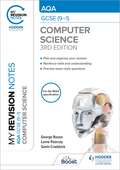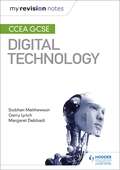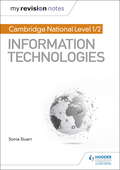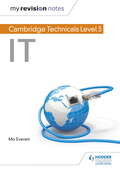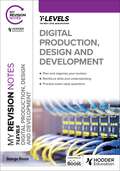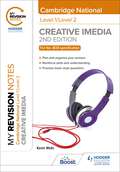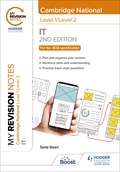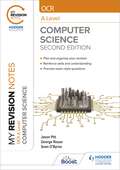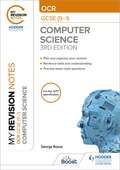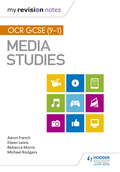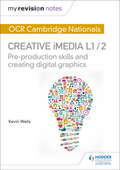- Table View
- List View
My Revision Notes: AQA GCSE (9-1) Computer Science, Third Edition
by George Rouse Gavin Craddock Lorne PearceyTarget exam success with My Revision Notes. Our updated approach to revision will help students learn, practise and apply skills and understanding. Coverage of key content is combined with practical study tips and effective revision strategies to create a guide students can rely on to build both knowledge and confidence.My Revision Notes: AQA GCSE Computer Science will help students:> Strengthen subject knowledge and key terms by working through clear and focused key content> Test understanding and identify areas for improvement with 'check your understanding' questions> Plan and manage a successful revision programme with the 'exam breakdown', 'countdown to the exams' and 'now test yourself' sections> Check answers to the practice questions against the answers provided> Enhance exam technique through exam-style questions and tips from a leading team of expert authors
My Revision Notes: CCEA GCSE Digital Technology
by Siobhan Matthewson Gerry Lynch Margaret DebbadiExam board: CCEALevel: GCSESubject: Digital TechnologyFirst teaching: September 2017First exams: Summer 2019Target success in CCEA GCSE Digital Technology, whichever route you choose, with our proven formula for effective, structured revision. Key coverage of the three examined units - Digital Technology, Digital Development Concepts and Digital Development Practice - is combined with practical tips to create a revision guide that students can rely on to review, strengthen and test their knowledge.With My Revision Notes, every student can:Consolidate subject knowledge by working through clear and focused content coverage.Test understanding and identify areas for improvement with a sample paper included within the book.Improve exam technique through tips written by leading authors and develop an understanding of assessment requirements of the examined units.Get exam ready with extra quick quizzes and answers to the practice questions
My Revision Notes: Cambridge National L1/2certificate In Information Tech Epub
by Sonia StuartEnhance your students' practical skills and develop their key content knowledge with this proven formula for effective, structured revision.Target success in OCR's Cambridge National Certificate in Information Technologies with this revision guide that brings together exam-style questions, revision tasks and practical tips to help students to review, strengthen and test their knowledge.With My Revision Notes, every student can:· Enjoy an interactive approach to revision, with clear topic summaries that consolidate knowledge and related activities that put the content into context.· Plan and manage a successful revision programme using the topic-by-topic planner.· Build, practice and enhance exam skills by progressing through revision tasks and Test Yourself activities.· Improve exam technique through exam-style questions and sample answers with commentary from an expert author and teacher.
My Revision Notes: Cambridge National Level 1/2 Certificate in Information Technologies
by Sonia StuartEnhance your students' practical skills and develop their key content knowledge with this proven formula for effective, structured revision.Target success in OCR's Cambridge National Certificate in Information Technologies with this revision guide that brings together exam-style questions, revision tasks and practical tips to help students to review, strengthen and test their knowledge.With My Revision Notes, every student can:· Enjoy an interactive approach to revision, with clear topic summaries that consolidate knowledge and related activities that put the content into context.· Plan and manage a successful revision programme using the topic-by-topic planner.· Build, practice and enhance exam skills by progressing through revision tasks and Test Yourself activities.· Improve exam technique through exam-style questions and sample answers with commentary from an expert author and teacher.
My Revision Notes: Cambridge Technicals Level 3 IT
by Maureen EverettEnhance your students' practical skills and develop their key content knowledge with this proven formula for effective, structured revision.Target success in OCR's Cambridge Technical Level 3 Information Technology with this revision guide that brings together exam-style questions, revision tasks and practical tips to help students to review, strengthen and test their knowledge.With My Revision Notes, every student can:- Enjoy an interactive approach to revision, with clear topic summaries that consolidate knowledge and related activities that put the content into context.- Plan and manage a successful revision programme using the topic-by-topic planner.- Build, practise and enhance exam skills by progressing through revision tasks and Test Yourself activities.- Improve exam technique with helpful hints, tips and 'Now Test Yourself' questions on how to approach the exams. Please note: answers are not provided for the exam-style questions and 'Test Yourself' activities
My Revision Notes: Cambridge Technicals Level 3 It Epub
by Maureen EverettEnhance your students' practical skills and develop their key content knowledge with this proven formula for effective, structured revision.Target success in OCR's Cambridge Technical Level 3 Information Technology with this revision guide that brings together exam-style questions, revision tasks and practical tips to help students to review, strengthen and test their knowledge.With My Revision Notes, every student can:- Enjoy an interactive approach to revision, with clear topic summaries that consolidate knowledge and related activities that put the content into context.- Plan and manage a successful revision programme using the topic-by-topic planner.- Build, practise and enhance exam skills by progressing through revision tasks and Test Yourself activities.- Improve exam technique through exam-style questions and sample answers with commentary from an expert author and teacher.- Get exam ready with answers to the activities available online
My Revision Notes: Ccea Gcse Digital Technology Epub
by Siobhan Matthewson Gerry Lynch Margaret DebbadiTarget success in CCEA GCSE Digital Technology, whichever route you choose, with our proven formula for effective, structured revision. Key coverage of the three examined units - Digital Technology, Digital Development Concepts and Digital Development Practice - is combined with practical tips to create a revision guide that students can rely on to review, strengthen and test their knowledge.With My Revision Notes, every student can:Consolidate subject knowledge by working through clear and focused content coverage.Test understanding and identify areas for improvement with a sample paper included within the book.Improve exam technique through tips written by leading authors and develop an understanding of assessment requirements of the examined units.Get exam ready with extra quick quizzes and answers to the practice questions
My Revision Notes: Digital Production, Design and Development T Level
by George RouseUnlock your full potential with this revision guide that will guide you through the knowledge and skills you need to succeed in the Digital Production, Design and Development T Level core exams.- Plan your own revision and focus on the areas you need to revise with key content summaries and revision activities for every topic- Understand key terms you will need for the exam with user-friendly definitions and a glossary- Breakdown and apply scientific and mathematic principles with clear worked examples- Use the exam tips to clarify key points and avoid making typical mistakes- Test yourself with end-of-topic questions and answers and tick off each topic as you complete it- Get ready for the exam with tips on approaching the paper, and sample exam questions
My Revision Notes: Digital Production, Design and Development T Level
by George RouseUnlock your full potential with this revision guide that will guide you through the knowledge and skills you need to succeed in the Digital Production, Design and Development T Level core exams.- Plan your own revision and focus on the areas you need to revise with key content summaries and revision activities for every topic- Understand key terms you will need for the exam with user-friendly definitions and a glossary- Breakdown and apply scientific and mathematic principles with clear worked examples- Use the exam tips to clarify key points and avoid making typical mistakes- Test yourself with end-of-topic questions and answers and tick off each topic as you complete it- Get ready for the exam with tips on approaching the paper, and sample exam questions
My Revision Notes: Digital Support Services and Digital Business Services T Levels
by George RouseUnlock your full potential with this revision guide that will guide you through the knowledge and skills you need to succeed in the Digital Support Services and Digital Business Services T Level core and pathway core exams.- Plan your own revision and focus on the areas you need to revise with key content summaries and revision activities for every topic- Understand key terms you will need for the exam with user-friendly definitions and a glossary- Breakdown and apply scientific and mathematic principles with clear worked examples- Use the exam tips to clarify key points and avoid making typical mistakes- Test yourself with end-of-topic questions and answers and tick off each topic as you complete it- Get ready for the exam with tips on approaching the paper, and sample exam questions
My Revision Notes: Digital Support Services and Digital Business Services T Levels
by George RouseUnlock your full potential with this revision guide that will guide you through the knowledge and skills you need to succeed in the Digital Support Services and Digital Business Services T Level core and pathway core exams.- Plan your own revision and focus on the areas you need to revise with key content summaries and revision activities for every topic- Understand key terms you will need for the exam with user-friendly definitions and a glossary- Breakdown and apply scientific and mathematic principles with clear worked examples- Use the exam tips to clarify key points and avoid making typical mistakes- Test yourself with end-of-topic questions and answers and tick off each topic as you complete it- Get ready for the exam with tips on approaching the paper, and sample exam questions
My Revision Notes: Level 1/Level 2 Cambridge National in Creative iMedia: Second Edition
by Kevin WellsSet your students on track to achieve the best grade possible with My Revision Notes: Level 1 / Level 2 Cambridge Nationals in Creative iMedia (J834).Our clear and concise approach to revision will help students learn, practise and apply their skills and understanding. Coverage of key content is combined with practical study tips and effective revision strategies to create a guide that can be relied on to build both knowledge and confidence.>> Consolidate knowledge with clear, concise and relevant content coverage, based on what examiners are looking for.>> Extend understanding with our regular 'Now Test Yourself', tasks and answers provided online for students to access.>> Improve technique through our increased exam support, including exam-style practice questions, expert exam tips and examples of typical mistakes to avoid.>> Identify key connections between topics and subjects with our 'Making Links' focus and further ideas for follow-up and revision activities.>> Plan and manage a successful revision programme with our topic-by-topic planner, new skills checklist and exam breakdown features, user-friendly definitions and glossary.
My Revision Notes: Level 1/Level 2 Cambridge National in Creative iMedia: Second Edition
by Kevin WellsSet your students on track to achieve the best grade possible with My Revision Notes: Level 1 / Level 2 Cambridge Nationals in Creative iMedia (J834).Our clear and concise approach to revision will help students learn, practise and apply their skills and understanding. Coverage of key content is combined with practical study tips and effective revision strategies to create a guide that can be relied on to build both knowledge and confidence.>> Consolidate knowledge with clear, concise and relevant content coverage, based on what examiners are looking for.>> Extend understanding with our regular 'Now Test Yourself', tasks and answers provided online for students to access.>> Improve technique through our increased exam support, including exam-style practice questions, expert exam tips and examples of typical mistakes to avoid.>> Identify key connections between topics and subjects with our 'Making Links' focus and further ideas for follow-up and revision activities.>> Plan and manage a successful revision programme with our topic-by-topic planner, new skills checklist and exam breakdown features, user-friendly definitions and glossary.
My Revision Notes: Level 1/Level 2 Cambridge National in IT: Second Edition
by Sonia StuartSet your students on track to achieve the best grade possible with My Revision Notes: Level 1 / Level 2 Cambridge Nationals in IT (J836).Our clear and concise approach to revision will help students learn, practise and apply their skills and understanding. Coverage of key content is combined with practical study tips and effective revision strategies to create a guide that can be relied on to build both knowledge and confidence.>> Consolidate knowledge with clear, concise and relevant content coverage, based on what examiners are looking for.>> Extend understanding with our regular 'Now Test Yourself', tasks and answers provided online for students to access.>> Improve technique through our increased exam support, including exam-style practice questions, expert exam tips and examples of typical mistakes to avoid.>> Identify key connections between topics and subjects with our 'Making Links' focus and further ideas for follow-up and revision activities.>> Plan and manage a successful revision programme with our topic-by-topic planner, new skills checklist and exam breakdown features, user-friendly definitions and glossary.
My Revision Notes: Level 1/Level 2 Cambridge National in IT: Second Edition
by Sonia StuartSet your students on track to achieve the best grade possible with My Revision Notes: Level 1 / Level 2 Cambridge Nationals in IT (J836).Our clear and concise approach to revision will help students learn, practise and apply their skills and understanding. Coverage of key content is combined with practical study tips and effective revision strategies to create a guide that can be relied on to build both knowledge and confidence.>> Consolidate knowledge with clear, concise and relevant content coverage, based on what examiners are looking for.>> Extend understanding with our regular 'Now Test Yourself', tasks and answers provided online for students to access.>> Improve technique through our increased exam support, including exam-style practice questions, expert exam tips and examples of typical mistakes to avoid.>> Identify key connections between topics and subjects with our 'Making Links' focus and further ideas for follow-up and revision activities.>> Plan and manage a successful revision programme with our topic-by-topic planner, new skills checklist and exam breakdown features, user-friendly definitions and glossary.
My Revision Notes: OCR A Level Computer Science: Second Edition
by George Rouse Sean O'Byrne Jason PittSet your students on track to achieve the best grade possible with My Revision Notes: OCR A Level Computer Science. Our clear and concise approach to revision will help students learn, practise and apply their skills and understanding. Coverage of key content is combined with practical study tips and effective revision strategies to create a guide that can be relied on to build both knowledge and confidence.With My Revision Notes: OCR A Level Computer Science, students can: > Consolidate knowledge with clear, focused and relevant content coverage, based on what examiners are looking for > Develop understanding with self-testing - our regular 'Now test yourself,' tasks and answers will help commit knowledge to memory > Improve technique through exam-style practice questions, expert tips and examples of typical mistakes to avoid > Identify key connections between topics and subjects with our 'Learning links' focus > Plan and manage a successful revision programme with our topic-by-topic planner, new exam breakdown feature, user-friendly definitions throughout and questions and answers online
My Revision Notes: OCR A Level Computer Science: Second Edition
by George Rouse Sean O'Byrne Jason PittSet your students on track to achieve the best grade possible with My Revision Notes: OCR A Level Computer Science. Our clear and concise approach to revision will help students learn, practise and apply their skills and understanding. Coverage of key content is combined with practical study tips and effective revision strategies to create a guide that can be relied on to build both knowledge and confidence.With My Revision Notes: OCR A Level Computer Science, students can: > Consolidate knowledge with clear, focused and relevant content coverage, based on what examiners are looking for > Develop understanding with self-testing - our regular 'Now test yourself,' tasks and answers will help commit knowledge to memory > Improve technique through exam-style practice questions, expert tips and examples of typical mistakes to avoid > Identify key connections between topics and subjects with our 'Learning links' focus > Plan and manage a successful revision programme with our topic-by-topic planner, new exam breakdown feature, user-friendly definitions throughout and questions and answers online
My Revision Notes: OCR A Level Media Studies
by Michael RodgersExam board: OCRLevel: A-levelSubject: Media StudiesFirst teaching: September 2017First exams: Summer 2018Target success in OCR A Level Media Studies with this proven formula for effective, structured revision; clear guidance is combined with exam-style questions and practical tips to create a revision guide that students can rely on to review, strengthen and test their knowledge and skills.With My Revision Notes every student can:- Plan and manage a successful revision programme using the topic-by-topic planner- Practise the enquiry, critical thinking and analytical skills they need, with 'Test yourself' questions and answers for Components 1 and 2- Understand what the examiner is looking for by comparing answers to sample student responses with commentary from experienced Media Studies teachers- Improve exam technique through expert tips, exam preparation advice and examples of typical mistakes to avoid- Revise, remember and accurately use key terms with definitions alongside the text for quick and easy reference- Feel confident undertaking the non-exam assessment (NEA), using a checklist for the 'Making media' production task in Component 3
My Revision Notes: OCR A Level Media Studies
by Michael RodgersExam board: OCRLevel: A-levelSubject: Media StudiesFirst teaching: September 2017First exams: Summer 2018Target success in OCR A Level Media Studies with this proven formula for effective, structured revision; clear guidance is combined with exam-style questions and practical tips to create a revision guide that students can rely on to review, strengthen and test their knowledge and skills.With My Revision Notes every student can:- Plan and manage a successful revision programme using the topic-by-topic planner- Practise the enquiry, critical thinking and analytical skills they need, with 'Test yourself' questions and answers for Components 1 and 2- Understand what the examiner is looking for by comparing answers to sample student responses with commentary from experienced Media Studies teachers- Improve exam technique through expert tips, exam preparation advice and examples of typical mistakes to avoid- Revise, remember and accurately use key terms with definitions alongside the text for quick and easy reference- Feel confident undertaking the non-exam assessment (NEA), using a checklist for the 'Making media' production task in Component 3
My Revision Notes: OCR GCSE (9-1) Computer Science, Third Edition
by George RouseTarget exam success with My Revision Notes. Our updated approach to revision will help students learn, practise and apply skills and understanding. Coverage of key content is combined with practical study tips and effective revision strategies to create a guide students can rely on to build both knowledge and confidence.My Revision Notes: OCR GCSE Computer Science will help students:> Strengthen subject knowledge and key terms by working through clear and focused key content> Test understanding and identify areas for improvement with 'check your understanding' questions> Plan and manage a successful revision programme with the 'exam breakdown', 'countdown to the exams' and 'now test yourself' sections> Check answers to the practice questions against the answers provided> Enhance exam technique through exam-style questions and tips from leading author George Rouse
My Revision Notes: OCR GCSE (9-1) Computer Science, Third Edition
by George RouseTarget exam success with My Revision Notes. Our updated approach to revision will help students learn, practise and apply skills and understanding. Coverage of key content is combined with practical study tips and effective revision strategies to create a guide students can rely on to build both knowledge and confidence.My Revision Notes: OCR GCSE Computer Science will help students:> Strengthen subject knowledge and key terms by working through clear and focused key content> Test understanding and identify areas for improvement with 'check your understanding' questions> Plan and manage a successful revision programme with the 'exam breakdown', 'countdown to the exams' and 'now test yourself' sections> Check answers to the practice questions against the answers provided> Enhance exam technique through exam-style questions and tips from leading author George Rouse
My Revision Notes: OCR GCSE (9–1) Media Studies
by Michael Rodgers Aaron French Eileen Lewis Rebecca MorrisExam board: OCRLevel: GCSESubject: Media Studies First teaching: September 2017First exams: Summer 2019Target success in OCR GCSE (9-1) Media Studies with this proven formula for effective, structured revision. Clear guidance is combined with exam-style questions and practical tips to create a revision guide that students can rely on to review, strengthen and test their knowledge and skills.With My Revision Notes every student can:- Plan and manage a successful revision programme using the topic-by-topic planner- Practise the enquiry, critical thinking and analytical skills they need, with 'Test yourself' questions and answers for Papers 1 and 2- Understand what the examiner is looking for by comparing answers to sample student responses with commentary from experienced Media Studies teachers- Improve exam technique through expert tips, exam preparation advice and examples of typical mistakes to avoid- Revise, remember and accurately use key terms with definitions alongside the text for quick and easy reference- Feel confident undertaking the non-exam assessment (NEA), using a checklist for the 'Creating media' production task
My Revision Notes: Ocr Gcse (9-1) Media Studies Epub
by Michael Rodgers Aaron French Eileen LewisExam board: OCRLevel: GCSESubject: Media Studies First teaching: September 2017First exams: Summer 2019Target success in OCR GCSE (9-1) Media Studies with this proven formula for effective, structured revision. Clear guidance is combined with exam-style questions and practical tips to create a revision guide that students can rely on to review, strengthen and test their knowledge and skills.With My Revision Notes every student can:- Plan and manage a successful revision programme using the topic-by-topic planner- Practise the enquiry, critical thinking and analytical skills they need, with 'Test yourself' questions and answers for Papers 1 and 2- Understand what the examiner is looking for by comparing answers to sample student responses with commentary from experienced Media Studies teachers- Improve exam technique through expert tips, exam preparation advice and examples of typical mistakes to avoid- Revise, remember and accurately use key terms with definitions alongside the text for quick and easy reference- Feel confident undertaking the non-exam assessment (NEA), using a checklist for the 'Creating media' production task
My Revision Notes: Pre-production skills and Creating digital graphics
by Kevin WellsManage your own revision with step-by-step support from experienced teacher and examiner Kevin Wells. Use specific case studies to improve your knowledge of business processes and topics. Apply business terms accurately with the help of definitions and key words.-Plan and pace your revision with the revision planner-Use the expert tips to clarify key points-Avoid making typical mistakes with key expert advice-Test yourself with end-of-topic questions and answers and tick off each topic as you complete it-Get exam ready with last minute quick quizzes at www.hoddereducation.co.uk/myrevisionnotes
My Revision Notes: Pre-production skills and Creating digital graphics
by Kevin WellsManage your own revision with step-by-step support from experienced teacher and examiner Kevin Wells. Use specific case studies to improve your knowledge of business processes and topics. Apply business terms accurately with the help of definitions and key words.-Plan and pace your revision with the revision planner-Use the expert tips to clarify key points-Avoid making typical mistakes with key expert advice-Test yourself with end-of-topic questions and answers and tick off each topic as you complete it-Get exam ready with last minute quick quizzes at www.hoddereducation.co.uk/myrevisionnotes
